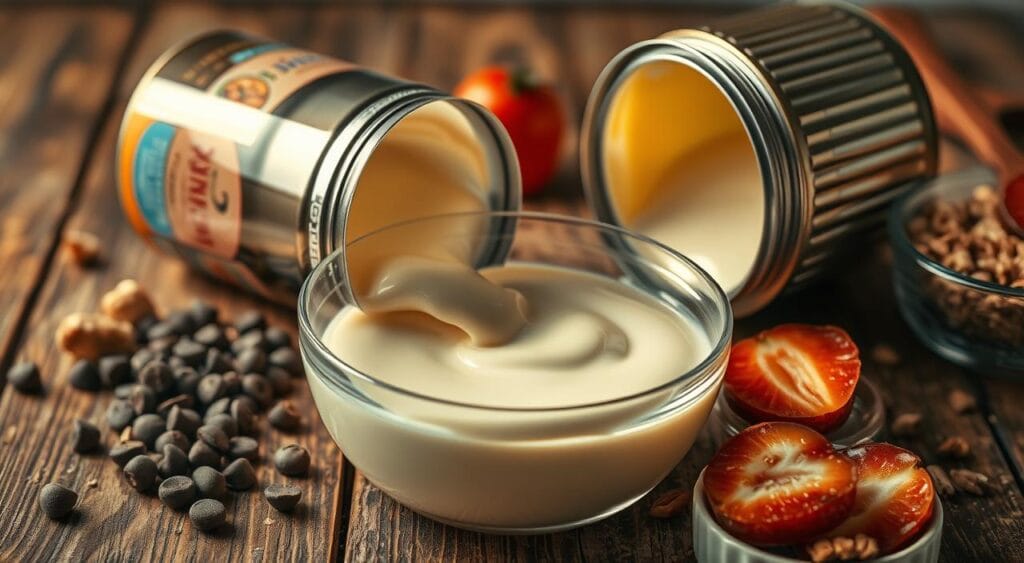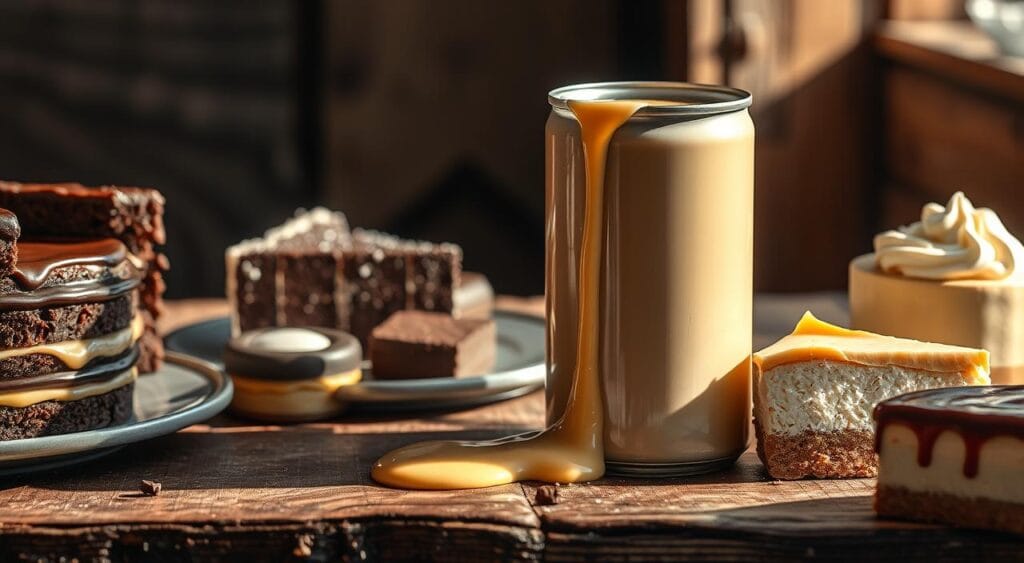Jump to:
Estimated reading time: 10 minutes
Table of contents
Why is condensed milk used in desserts? Condensed milk, also known as sweetened condensed milk, is a thick, creamy, and ultra-delicious milk product. It’s used as a key ingredient in many desserts worldwide. It’s made by removing 60% of the water from cow’s milk and adding sugar. This gives it a rich, caramel-like flavor.
This makes milk perfect for adding sweetness, and texture. It’s great in baked goods, no-bake desserts, and treats like fudge and tres leches cake.
Why is condensed milk used in desserts? Key Takeaways
- Condensed milk enhances the moisture content and texture of cakes and other baked goods.
- It adds a smooth, creamy consistency to fudge, and other candies.
- Condensed milk can be used to create a sweet, crunchy coating on popcorn or a glaze for pies and tarts.
- The rich, caramel-like flavor of condensed milk complements coffee and other desserts perfectly.
- Many bakers keep sweetened condensed milk on hand as a versatile ingredient for a variety of dessert recipes.
Why is condensed milk used in desserts? Introduction
Condensed milk has a long history, starting in the 13th century. Marco Polo first mentioned the Tatars’ method of condensing milk. In the 1800s, both France and the United States independently created sweetened condensed milk. It was a way to keep milk fresh for longer.
Today, sweetened condensed milk is a key ingredient in desserts. Its thick, creamy texture make it perfect for many recipes. It adds moisture to treats like fudge, ice cream.
Condensed milk is also used in baked goods. It makes cookies, cakes, and bars moist and indulgent. Its long shelf life and sweet flavor make it a valuable addition to any pantry.
The what is condensed milk question has an answer. It’s a versatile ingredient that enhances many dishes. From sweet desserts to savory sauces, it adds a delightful touch.
“Condensed milk is a versatile and indispensable ingredient that can elevate the flavor and texture of countless desserts.”
Exploring sweetened condensed milk in desserts further, we’ll look at its role in baking. We’ll also discuss its popular uses and how to use it healthily.

The Unique Characteristics of Condensed Milk in Desserts
Condensed milk is a versatile ingredient that brings a wealth of unique characteristics to desserts. Its distinct properties make it an indispensable choice for bakers.
Rich and Creamy Texture
The process of removing 60% of the water content from regular milk results in a thick, rich and creamy texture. This texture adds a luxurious mouthfeel to baked goods and no-bake treats. It enhances the overall creaminess of desserts.
Natural Sweetness
During the condensing process, sugar is added to the milk. This gives condensed milk a natural sweetness that can reduce the need for additional sweeteners in recipes. This inherent sweetness provides a balanced flavor profile in desserts.
Extended Shelf Life
The high sugar content and lack of water in condensed milk helps extend its shelf life. It can be stored for extended periods without refrigeration. This makes it a convenient ingredient for dessert preparations.
| Characteristic | Benefit in Desserts |
|---|---|
| Rich and creamy texture | Enhances the overall indulgence and mouthfeel of desserts |
| Natural sweetness | Reduces the need for additional sweeteners in recipes |
| Extended shelf life | Allows for convenient storage and use in dessert preparations |

“Condensed milk is a unique and versatile ingredient that can transform the texture, sweetness, and shelf life of desserts. It’s an essential component in many beloved recipes.”
How Condensed Milk Enhances Dessert Recipes
Condensed milk makes desserts richer and creamier. Its thick, smooth texture and sweetness are great for many sweet treats. It’s perfect for custards and baked goods.
Creating Smooth, Velvety Consistency
The velvety texture of condensed milk makes desserts feel luxurious. It turns puddings, custards, and no-bake desserts into silky, creamy treats that are a joy to eat.
Enhancing Flavors in Baked Goods
Condensed milk’s caramel-like sweetness boosts the flavors of chocolate, coffee, and spices in baked goods. It can improve the taste in baked goods, making them indulgent.
Reducing the Need for Additional Sweeteners
Condensed milk’s natural sweetness can cut down on extra sugar in desserts. This makes them more indulgent. Adjusting sugar amounts when using condensed milk helps balance flavors.
“Condensed milk exemplifies simplicity in producing delightful flavors in various dessert recipes.”
Condensed milk is great in baked goods, custards, and no-churn ice creams. It shows how versatile it is for sweet treats.
Popular Desserts That Use Condensed Milk
Condensed milk is loved in many sweet treats worldwide. It’s found in the famous tres leches cake, fudgy chocolate brownies, and creamy caramel flan. This sweet and thick milk adds a special richness and creaminess to desserts.
Classic Tres Leches Cake
The tres leches cake is a top dessert with condensed milk. It’s a moist sponge cake soaked in condensed milk, evaporated milk, and whole milk. This makes it incredibly creamy and sweet, making each bite unforgettable.
Fudgy Chocolate Brownies
Condensed milk is key in making fudgy chocolate brownies. It adds richness and natural sweetness, making the brownies dense and moist. The condensed milk also helps the ingredients stick together, creating a fudgy and decadent treat.
Creamy Caramel Flan
The creamy caramel flan also uses condensed milk. It’s a custard-like dessert with a silky smooth texture and flavor. The condensed milk makes the caramel topping, balancing richness and sweetness in every bite.
Condensed milk is a must-have in the kitchen for desserts. It’s used in the tres leches cake, fudgy brownies, and caramel flan. These desserts are loved for their texture, moisture, all thanks to condensed milk.
The Science Behind Condensed Milk in Baking
Condensed milk is a versatile ingredient in baking, thanks to its unique properties. It affects moisture, browning, and shelf stability in desserts. Knowing how it works can help bakers create better treats.
How Condensed Milk Affects Moisture Content
Condensed milk has less water than regular milk, making it thicker and creamier. This means it can keep baked goods moist for longer. The sugars and proteins in it also help keep desserts soft and tasty.
The Role of Lactose in Browning
The lactose in condensed milk is key to the Maillard reaction during baking. This reaction creates the rich colors and flavors we love in desserts. The more lactose, the better the browning, making desserts look and taste amazing.
The Impact on Shelf Stability
Condensed milk’s high sugar content also helps baked goods last longer. The sugars in it act as natural preservatives. This slows down the growth of bad bacteria and keeps desserts fresh for longer.
Condensed milk’s role in baking is fascinating. It’s not just about adding sweetness. It’s about enhancing moisture, browning, and shelf life. Bakers can use this to make treats that are not only delicious but also last longer.
Substituting Condensed Milk in Dessert Recipes
Condensed milk is a favorite in many desserts. But sometimes, you might need a different ingredient. This could be for less sugar or to fit dietary needs. There are many options for replacing condensed milk.
How to Replace with Evaporated Milk and Sugar
You can make a homemade condensed milk mix. Use evaporated milk and sugar. It’s a bit like the real thing but might need some tweaking. Start with equal parts of each, then adjust the sugar to taste.
Using Dairy-Free Alternatives
If you’re on a dairy-free diet, try coconut milk or almond milk. They’re not the same but still creamy and tasty. They work well in desserts.
Adjusting for Texture and Flavor Changes
Changing ingredients can affect how your dessert turns out. You might need to add or take away things like liquid or sugar. Try small batches to get it just right.
“Substituting condensed milk can be a bit of a balancing act, but with some trial and error, you can find the perfect alternative to suit your needs.”
Exploring different ingredients can keep your desserts delicious. It’s all about finding the right mix for your taste and needs.
Health Considerations of Using Condensed Milk in Desserts
Condensed milk adds a rich, creamy texture and natural sweetness to desserts. But, it’s important to think about its health effects. It’s high in calories and sugar, which can lead to weight gain and health issues if eaten too much.
Caloric and Sugar Content
Condensed milk is very calorie-dense, with 321 calories per 100 grams. Most of these calories come from its 54 grams of sugar per 100 grams. Just 2 tablespoons (30 grams) of it can add over 10 grams of sugar to a dish.
This can be a problem for those watching their sugar intake. It can cause weight gain, tooth decay, and increase the risk of type 2 diabetes.
Nutritional Alternatives
For those trying to cut down on sugar, evaporated milk is a better choice. It has fewer calories, less fat, and less sugar than sweetened condensed milk. Also, dairy-free options like coconut milk or almond milk are good for those with lactose intolerance or milk allergies.
Portion Control Tips
- Start with small amounts of condensed milk in recipes and gradually increase to find the right balance of flavor and texture.
- Use condensed milk as a topping or drizzle rather than incorporating it directly into the recipe, allowing you to control the portion size.
- Pair condensed milk desserts with fresh fruits or other nutrient-dense ingredients to help offset the high caloric and sugar content.
- Be mindful of serving sizes and consider sharing or dividing larger portions of condensed milk-based desserts.
Knowing the nutritional facts of condensed milk and using portion control can help you enjoy its taste in desserts. This way, you can keep your diet balanced and healthy.
FAQ: Common Questions About Using Condensed Milk in Desserts
Using condensed milk in desserts can raise a few questions. Let’s look at some common ones and offer tips on using this ingredient in sweet treats.
Can I Substitute Condensed Milk for Regular Milk in Recipes?
Yes, you can use condensed milk instead of regular milk in many desserts. But remember, condensed milk is thicker and sweeter. You might need to add water or use less sugar in the recipe.
How Do I Adjust the Sweetness When Using Condensed Milk?
Condensed milk is sweeter than regular milk, so you might need to cut down on sugar. Try reducing sugar by 1/4 to 1/3. You can also balance sweetness with a pinch of salt, a splash of lemon, or a bit of unsweetened cocoa.
What Are Some Tips for Baking with Condensed Milk?
Add condensed milk slowly, tasting and adjusting as you go to get the right sweetness and texture.
Use unsweetened condensed milk for less sweet desserts.
Adjust baking times and temperatures since condensed milk changes moisture and texture.
Try adding vanilla, almond extract, or spices to enhance the rich taste of condensed milk.
Remember these tips to make tasty desserts with condensed milk. Check out dessert recipes that use condensed milk for ideas.
Conclusion
Condensed milk is a key ingredient in desserts, known for its rich, creamy texture, natural sweetness, and extended shelf life. It makes desserts like tres leches cake, chocolate brownies, and caramel flan even better. It adds flavor and texture to many baked goods and no-bake treats.
Knowing how condensed milk works in baking is important. It lets home cooks and bakers make amazing desserts. They can adjust sweetness and flavors to make desserts even more special.
The article shows how using condensed milk can turn simple desserts into something amazing. It shows how this ingredient is a game-changer in cooking. Whether you’re an experienced baker or just starting, trying out condensed milk can lead to many tasty discoveries.






